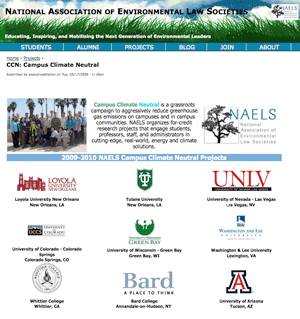(This article appears in the July, 2010 issue of The ACUPCC Implementer)
What would it cost to get an entire campus to run on power from renewable sources? How do you sell expensive sustainability measures to a community still skeptical about global warming? What steps can a campus community take to get a diverse community of students, faculty, administrators, and staff out of their comfortable, convenient cars?

Over the past eight months, close to 100 students, 20 administrators, and 15 professors on 10 campuses across the country worked hard, with support from the National Association of Environmental Law Societies (NAELS), to answer these and other tough sustainability questions.
These ten diverse projects were part of a series of Campus Climate Neutral (CCN) projects hosted by NAELS in 2009-2010. Each project was undertaken in partnership with a campus that had signed the American College & University Presidents’ Climate Commitment (ACUPCC). At each campus, NAELS worked with the ACUPCC Implementation Liaison to recruit a project team of professors and students to undertake a semester or year-long project to catalyze the campus Climate Action Planning process.
Over the course of the academic year this pioneering group:
- Conducted feasibility studies for tidal, wind, geothermal, and solar for Tulane.
- Launched a communications planning process for UC – Colorado Springs.
- Updated a sustainability plan for the Green Bay campus of the U of WI system.
- Designed a $/MW saving campaign for transportation & electricity at Whittier.
- Analyzed the impact of compost, water, lighting, and behavior change at U of AZ.
- Drafted a Climate Action Plan for the University of Nevada – Las Vegas.
- Laid the groundwork for a Climate Action Planning course at Washington & Lee.
- Brought together New Orleans area leaders for collaborative campus planning.
- Created a set of recommendations to advance sustainability at Bard College.
- Convinced the administration at St. Augustine’s to sign the ACUPCC.
Supporting ten projects was quite a learning experience, particularly when dealing with a wide diversity of students, faculty, administrators, laws, regulations, fields, cultures, and geography. Combined, these ten campuses comprised a 100,000 person system, operating within 30 million sq ft of university space in 9 states. The students, professors, and Implementation Liaisons came from the fields of finance, law, business, policy, biology, sociology and communications.
What emerged was the notion that everything is sustainability. Or, more accurately put, every discipline that deals with people and the world around us, can and should address sustainability. These graduates and undergraduates sharpened their teeth with real world projects that broke down the traditional academic silos that separate disciplines and fields. In the process, these students received training and experience, professors got experience teaching sustainability, and implementation liaisons received support in the difficult task of fulfilling their ACUPCC commitments. The campus community got climate champions at all levels, changing the behavior and attitudes of their classmates and colleagues. Win-win-win-win.
Although these projects, and others like them at ACUPCC signatory institutions around the country, are inspiring examples of communities coming together to plan and create large, complex climate neutral systems, it is easy get too excited about all the progress these campuses are making and how their progress will affect climate change in the short term. The collective carbon footprint of these ten campuses, about 650,000 metric tons of CO2 equivalent, only accounts for only a little over 0.01% of total national emissions that reached 5,833 million metric tons of CO2 equivalent in 2007.
How fortunate then, that these projects have helped to create 100 carbon reduction specialists. These future professionals, parents, and citizens now know how to analyze, plan, and sell energy efficiency and conservation and renewable energy projects. Many will go on to help lead similar efforts in their offices, homes, campuses, municipalities, counties, and states.
NAELS has set up a website to share experiences, resources, and contacts from our 2009-2010 projects. NAELS is also currently laying the groundwork and seeking funding support for a set of projects in 2010-2011 that will build on this past year’s work. If you would like to apply for a future CCN project, please fill out the survey here.

Add new comment